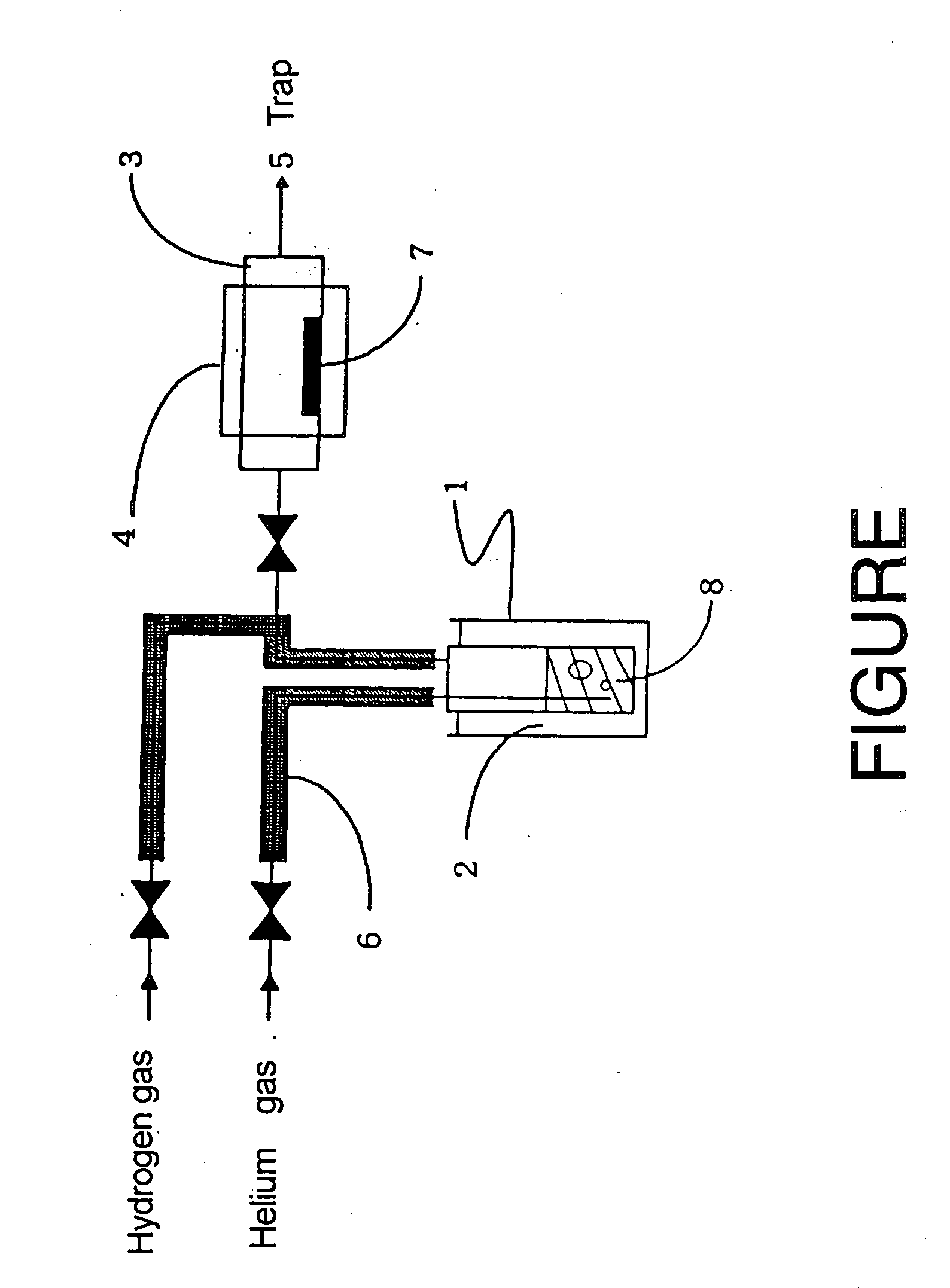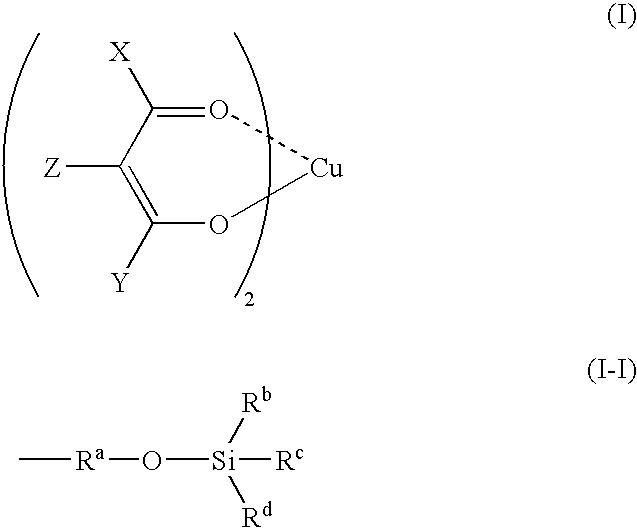Copper complexes and process for formatiom of copper-containing thin films by using the same
a technology of copper-containing thin films and copper complexes, applied in the field of copper complexes, can solve the problems of low thin film production rate, thermal instability of -diketonato copper (i) and other problems, and achieve the effect of low melting point and thermal stability
- Summary
- Abstract
- Description
- Claims
- Application Information
AI Technical Summary
Benefits of technology
Problems solved by technology
Method used
Image
Examples
example 1
(1) Synthesis of 2,6-dimethyl-2,6-di(trimethylsilyloxy)-3,5-heptadione [Represented by the Formula (V)′, Hereinafter Referred to as “dsobd”]
In a 50 mL-volume flask were placed 1.80 g (45.0 mmol) of 60′ sodium hydride and 9.83 g (51.7 mmol) of methyl 2-(trimethylsilyloxy)-2-methyl-propionate. The resulting solution was heated to 120° C., and to the heated solution was dropwise added slowly a solution of 3.00 g (17.2 mmol) of 2-(trimethylsilyloxy)-2-methyl-3-butanone in 9 mL of toluene. After the dropwise addition was complete, the reaction mixture was heated at 120° C. for one hour. Subsequently, the reaction mixture was cooled to room temperature and made weak acidic by the addition of an acetic acid-toluene mixture. The precipitated sodium acetate was removed by filtration, to obtain a yellow solution.
The obtained solution was concentrated and purified by column chromatography using dehydrated silica gel, to give 1.20 g (3.61 mmol, yield 21%) of the desired main product, i.e., ...
example 2
(1) Synthesis of 2,6,6-trimethyl-2-(trimethylsilyloxy)-3,5-heptadione [Represented by the Formula (III)′, Hereinafter Referred to as “sobd”]
In a 50 mL-volume flask, 0.40 g (10.3 mmol) of sodium amide and 1.20 g (12.0 mmol) of pinacolin were suspended in 3 mL of toluene, and the resulting suspension was stirred for 30 min. at room temperature. Subsequently, a solution of 1.00 g (5.25 mmol) of methyl 2-(trimethylsilyloxy)-2-methyl-propionate in 6 mL of toluene was dropwise added slowly. After the dropwise addition was complete, the mixture was subjected to reaction for one hour at room temperature. The reaction mixture was then made weak acidic with an acetic acid-toluene mixture. The precipitated sodium acetate was removed by filtration to give a yellow solution.
The obtained solution was concentrated and purified by column chromatography using dehydrated silica gel, to give 0.83 g (3.21 mmol, yield 61%) of the desired main product, i.e., 2,6,6-trimethyl-2-(trimethylsilyloxy)-3,5-...
example 3
(1) Synthesis of 2,6-dimethyl-2-(trimethylsilyloxy)-3,5-heptadione [Represented by the Formula (VIII)′, Hereinafter Referred to as “sopd”]
In a 50 ml-volume flask, 0.50 g (12.8 mmol) of sodium amide and 0.45 g (5.22 mmol) of 3-methyl-2-butanone were suspended in 1.5 g of hexane, and the resulting suspension was stirred at 15° C. for 30 min. Subsequently, a solution of 1.20 g (6.31 mmol) of methyl 2-(trimethylsilyloxy)-2-methyl-propionate in 3 g of hexane was dropwise added slowly. After the dropwise addition was complete, the mixture was subjected to reaction at 15° C. for one hour. The reaction mixture was then made weak acidic with an acetic acid-toluene mixture. The precipitated sodium acetate was removed by filtration to give a yellow solution.
The obtained solution was concentrated and purified by column chromatography using dehydrated silica gel, to give 0.91 g (3.71 mmol, yield 71′) of the desired main product, i.e., 2,6-dimethyl-2-(trimethylsilyloxy)-3,5-heptadione.
The p...
PUM
| Property | Measurement | Unit |
|---|---|---|
| melting point | aaaaa | aaaaa |
| β | aaaaa | aaaaa |
| metallic | aaaaa | aaaaa |
Abstract
Description
Claims
Application Information
 Login to View More
Login to View More - R&D
- Intellectual Property
- Life Sciences
- Materials
- Tech Scout
- Unparalleled Data Quality
- Higher Quality Content
- 60% Fewer Hallucinations
Browse by: Latest US Patents, China's latest patents, Technical Efficacy Thesaurus, Application Domain, Technology Topic, Popular Technical Reports.
© 2025 PatSnap. All rights reserved.Legal|Privacy policy|Modern Slavery Act Transparency Statement|Sitemap|About US| Contact US: help@patsnap.com



